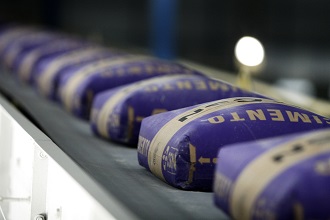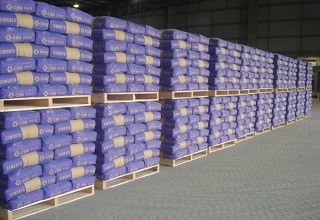Ínico do conteúdo da página
Overview
Portland cement is the most used material in construction and there are various types of cement, suitable for all types of applications. It may be sorted by its strength: 25 MPa (unit of measurement used to calculate resistance), 32 MPa or 40 MPa, representing the minimum resistance to compression in the period of 28 days (curing time).
It can also be classified as RS (Resistant to Sulphates), standardized through NBR 5737, i.e., resistant to sewage water, sea water and certain types of soils with aggressive compounds.
CSN currently produces cements CPII E-32, CP III-32 and CP III-40 RS.


CP III-32 and CP III-40 RS
CP III-32 and CP III-40 RS are standardized by the Brazilian Association of Technical Standards (ABNT) under No. NBR 5735. In both types, the industrial productions are made by grinding clinker and granulated blast furnace slag, also known as LHS – Ligand Hydraulic Steel.
In the case of CP III, the addition of blast-furnace slag in the composition contributes to the increased ultimate strength of concrete and mortar. Also, it is this same slag that is responsible for the lighter color of CP III when compared to other cement classes. That is, the cement color is determined by the raw material components in the product, not having any relation with the resistance of the concrete. The mixture of cement, water and other materials of construction, such as sand and gravel, produce mortars and concretes for the most diverse applications.
The use of blast furnace slag in CP III has technical advantages that give more durability and, consequently, less permeability.
Among the many advantages of the CSN CP III cement, the following are highlighted:
- Reduction of cracks and fissures;
- Greater durability;
- Lower permeability;
- High efficiency in aggressive mediums (e.g., saline environments, marshy soils, rivers with industrial waste and sewage);
- Environmentally friendly product.
The main applications of cement CP III are: foundations, mass or armed concrete structures, mortars of various types, concrete artifacts, special foundations as in maritime works and works subject to aggressive waters.
Physical Characteristics and Composition
Mass ratio for composition of CP III
| TYPE OF CEMENT |
CLINKER AND PLASTER |
GRANULATED SLAG FROM BLAST FURNACE |
CARBONATE MATERIAL |
| CP III |
25 – 65% |
35 – 70% |
0 – 5% |
Main physical characteristics of cement CP III
| TYPE OF CEMENT |
Class |
RESISTANCE TO COMPRESSION |
THINNESS |
TAKING TIME |
SCALABILITY |
MPa
3 days |
MPa
7 days |
MPa
28 days |
MPa
91 days |
Residue on Sieve
75 µm |
Start
(Hours) |
End
(Hours) |
Cold
(mm) |
Hot
(mm) |
| CP III |
40 |
≥ 12 |
≥ 23 |
≥ 40 |
≥ 48 |
≤ 8.0 |
≥ 1 |
≤ 12 |
≤ 5 |
≤ 5 |
| 32 |
≥ 10 |
≥ 20 |
≥ 32 |
≥ 40 |
CP II-E-32
Made according to NBR 11578 standard, Portland cement CP II-E is a compound cement produced from calcium silicate, aluminum, iron, calcium, sulfate, carbonate filler and low addition of blast furnace slag, ensuring that the product has higher initial resistance and is suitable for general construction, exposed to attack of moderate sulphate. The addition of slag also decreases the probability of cracking of thermal origin.
Among the many advantages of the CSN CP II-E cement, the following are highlighted:
- Versatility;
- Fast drying;
- Higher initial resistance;
- Environmentally friendly.
The main applications of CP II cement are: concrete artifacts, concrete blocks, slabs, industrial floors and sidewalks, foundations, laying of mortars and coating, concrete structures, emergency works and building repairs, such as machine bases and plants where more rapid curing is required.
Physical Characteristics and Composition
Mass ratio for composition of CPII E-32
| TYPE OF CEMENT |
CLINKER AND PLASTER |
GRANULATED SLAG FROM BLAST FURNACE |
CARBONATE MATERIAL |
| CP II E |
56 – 94% |
6 – 34% |
0 – 10% |
In the table below you can evaluate the characteristics and physical properties of CP II-E-32 cement at the start and end of handling, hot and cold expandability, and compressive strength in periods of 3, 7 and 28 days:
Main physical characteristics of cement CP II
| TYPE OF CEMENT |
Class |
THINNESS |
TAKING TIME |
SCALABILITY |
RESISTANCE TO COMPRESSION |
Residue on Sieve
75 µm |
Start
(Hours) |
End
(Hours) |
Cold
(mm) |
Hot
(mm) |
3 days
(MPa) |
7 days
(MPa) |
28 days
(MPa) |
91 days
(MPa) |
| CP II |
E-32 |
≤ 12.0 |
≥ 1 |
≤ 10 |
≤ 5 |
≤ 5 |
≥ 10 |
≥ 20 |
≥ 32 |
– |
CP II E-40
CP II E-40
Physical Characteristics and Composition
| TYPE OF CEMENT |
Class |
THINNESS |
TAKING TIME |
SCALABILITY |
RESISTANCE TO COMPRESSION |
Residue on Sieve
75 µm |
Start
(Hours) |
End
(Hours) |
Cold
(mm) |
Hot
(mm) |
3 days
(MPa) |
7 days
(MPa) |
28 days
(MPa) |
91 days
(MPa) |
| CP II |
E-40 |
≤ 10,0 |
≥ 1 |
≤ 10 |
≤ 5 |
≤ 5 |
≥15 |
≥ 25 |
≥ 40 |
– |
Last update on
November 20, 2020.
Back
Top


 Contraste
Contraste